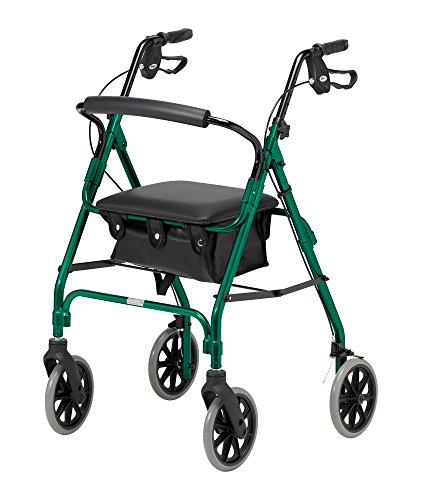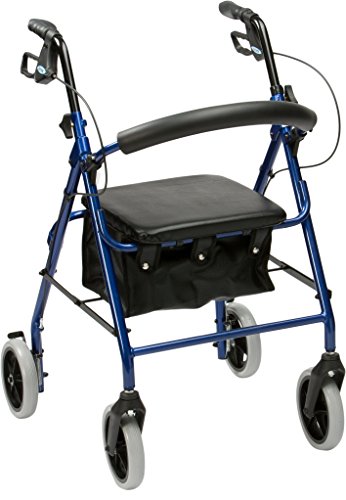See What Seated Rollator Tricks The Celebs Are Using
페이지 정보
작성자 Pasquale 댓글 0건 조회 45회 작성일 24-09-20 00:04본문
 The Convenience of a Sitting Rollator
The Convenience of a Sitting RollatorThe seated rollator is compact and lightweight which makes it easy to transport and store. This makes it possible for seniors to be active in their communities and engage in daily activities with a new sense of confidence and dignity.
Keeping a seated rollator in good condition is essential to ensuring safety. Regular inspections of the brakes and wheels can prevent accidents or breakdowns.
Stability
The frame of a rollator seats designed for seated use is usually made of durable materials such as aluminum or steel. This provides durability and stability. The frame assists in supporting the user's weight, which makes it easier for them to stay upright and maintain their balance while sitting. This is essential for people who suffer from mobility impairments since they can sit without having to locate chairs or lean against something.
 The most common type of brake on a seated rollator is the cable loop brake system, that functions similar to the brakes on bikes. Users press the handles and levers simultaneously using both hands to activate the brakes. When the brakes are activated, they remain locked until the user releases them and begins walking again. This type of braking system is extremely convenient for users, as it allows them to easily and safely stop their rollator in any environment.
The most common type of brake on a seated rollator is the cable loop brake system, that functions similar to the brakes on bikes. Users press the handles and levers simultaneously using both hands to activate the brakes. When the brakes are activated, they remain locked until the user releases them and begins walking again. This type of braking system is extremely convenient for users, as it allows them to easily and safely stop their rollator in any environment.This research shows that seated rollators increase mobility stability for young, able-bodied people when the handle height is properly adjusted and placed. This includes less preparation time required to achieve the seat-off position, improved control of COPfeet and sway zone when sitting down and standing up, and an upright standing posture when achieving an upright posture. The improved stability of movement is due to the additional sensorimotor input provided by full rollator support compared to touch, which only gives spatial information in the form of a haptic cue.
To use a seated rollator sit close to it with your back against the seat, and then grab onto the handles for support. To stop the seated rollator from moving away, make sure the brakes are locked prior to moving forward. You should sit down slowly and gently on the seat, ensuring that your feet are planted directly and firmly underneath your. Once you feel balanced, slowly lean forward and grip the handles to help you transfer your body weight to your legs. When you're ready take off the brakes and align yourself between the rear wheels of the seated rollator.
Convenience
As opposed to a regular walker a seated rollator offers a built-in seat to offer resting support when needed. This can be especially helpful for those who have to endure long periods of standing everyday activities. The waiting room of an appointment with a doctor or at the checkout of a grocery store isn't easy for those with mobility issues. With the ability to sit down, a seated rollator can help them rekindle ways to enjoy themselves and gain independence that would have been impossible without it.
Rollators come in a variety of designs to meet the needs of different users. The frame is typically lightweight and sturdy, which helps to improve mobility and walking speed, as well as self-confidence. The frame is often made of aluminum to provide a comfortable feel, while still providing the required strength for people with weight restrictions. A comfortable seat with a cushion and storage options are often found on these mobility aids.
When evaluating a seated rollator when evaluating a seated rollator, it is essential to consider the height of the handles and the seat. To determine the correct handle height, the user has to wear normal shoes with arms close to their sides and their elbows slightly bent. This measurement will determine the handle size that is the most comfortable and safe. It is possible to use the same method to determine the proper seat-to floor height. The ideal height for a seat must be able to accommodate the user while sitting down with their feet sitting on the ground.
A seated rollator should include hand brakes to facilitate quick stopping and help maintain control over the device when it is not in use. These brakes are similar to brakes on bicycles and can be engaged by simultaneously pressing both handles and levers. Some models even include slow-down brakes, which provide additional security when going downhill to prevent the device from rolling away from the user.
For additional convenience, a seated rollator can be outfitted with a basket that can be used to store personal items, groceries, or other necessities for shopping. The baskets are usually designed to fold with the unit, making it easy to carry and store when not in use. Also, walker trays and cup holders can be connected to the handles of a seated rollator for easy access to snacks and beverages while walking.
Safety
The safety of a seated rollator depends in part on the user's ability to keep their balance and to move the device in a safe manner. It is also essential to be aware of the terrain and be aware when driving on doorsteps or curbs. The device's brakes should be secured before the user sits down on the seat and disengaged when they are ready to stand.
One way to improve stability is to adjust the handle height to match the natural arm length of the user. This eases strain and promotes a better posture. Avoid leaning or hunching on the handles too much while walking. This can cause fatigue.
The type of brake system you choose is crucial. Most rollators that have seats come with brakes that lock. This ensures that the device doesn't accidentally slide away while the user is in a seat. The most common type of brake is the cable loop system, that functions similar to the brakes found on adult bicycles. To engage the brakes the user presses one or both levers located on either side of their seat. This method is perfect for users who lack the strength to operate a pull-down brake or are prone to forgetting to activate brakes.
A seated rollator gives the option of resting while out in public without having to find or fight for an appropriate chair which can be tiring and uncomfortable on joints that are sensitive. This feature is particularly useful in crowded places like stadiums and park in places where finding a chair at the right height could be a challenge.
Most rollators come with bags or baskets to store items such as food, medications and personal hygiene items. Some models have an additional compartment underneath the seat to give you more storage space. There are numerous accessories that can be purchased separately, including cups holder and a snack tray and an organizer for bags. Be aware that modifications that are not authorized or the use non-original accessories could pose safety hazards and may void any warranty on the device. It is suggested that users consult the manufacturer or dealer regarding any modifications or improvements they might wish to make.
Customization
Rollators come in a variety of sizes and shapes to meet the requirements of users. For instance for those looking for lightweight and compact design that can easily maneuver in tight spaces, a three wheeled model is usually a great option. These models are more compact and lighter with frames that can be folded and easily fit into the trunk.
Four-wheeled rollators offer greater stability than the three-wheeled models and are a great choice for those who have mobility issues that are more serious. Their four wheels evenly distribute weight and allow them to move over various surfaces both indoors and out. These models are also usually equipped with a seat to provide a comfortable space for people to relax on longer trips.
Some rollators come with storage spaces that can accommodate personal belongings. This allows users to be moving without having to return back to their vehicle to pick up more items. Storage options are a great way to keep everyday items in reach. This decreases the risk of falling when reaching for something from a remote place.
Another feature that can make a person who uses a rollator feel more self-reliant is the option to customize their device with additional accessories and features. This can include a bag or basket for transporting snacks, medication or other things and helps to keep them organized when traveling. Some rollators come with brake handles that are ergonomically designed to relieve hand pressure and allow users to manage their device easily, and some come with a locking mechanism for stopping or parking the unit.
Rollators can be adjusted to fit the height of their users. These adjustments can be made quickly and easily by the use of a simple knob, which allows anyone to set their preferred height. There are also a variety of hand-brake designs that include loop-lock brakes, which require the hands of the user to be placed into the hard loops of plastic on the handlebars or push-down brakes, similar to bicycle brakes. Certain manufacturers offer bariatric models that have wider seats to accommodate larger people.
댓글목록
등록된 댓글이 없습니다.